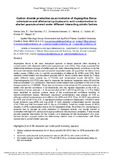JavaScript is disabled for your browser. Some features of this site may not work without it.
| dc.contributor.author | Garcia-Cela, Esther | |
| dc.contributor.author | Gari Sanchez, F. J. | |
| dc.contributor.author | Sulyok, Michael | |
| dc.contributor.author | Verheecke-Vaessen, Carol | |
| dc.contributor.author | Medina, Angel | |
| dc.contributor.author | Kruska, Rudolf | |
| dc.contributor.author | Magan, Naresh | |
| dc.date.accessioned | 2019-12-05T19:46:21Z | |
| dc.date.available | 2019-12-05T19:46:21Z | |
| dc.date.issued | 2019-10-24 | |
| dc.identifier.citation | Garcia-Cela E, Sanchez FG, Sulyok M, et al., (2020) Carbon dioxide production as an indicator of Aspergillus flavus colonisation and aflatoxins/cyclopiazonic acid contamination in shelled peanuts stored under different interacting abiotic factors. Fungal Biology, Volume 124, January 2020, pp.1-7 | en_UK |
| dc.identifier.issn | 1878-6146 | |
| dc.identifier.uri | https://doi.org/10.1016/j.funbio.2019.10.003 | |
| dc.identifier.uri | http://dspace.lib.cranfield.ac.uk/handle/1826/14803 | |
| dc.description.abstract | Aspergillus flavus is the main xerophylic species colonising stored peanuts resulting in contamination with aflatoxins (AFs) and cyclopiazonic acid (CPA). This study evaluated the relationship between storage of shelled peanuts under interacting abiotic conditions on (a) temporal respiration (R) and cumulative CO2 production, (b) dry matter losses (DMLs) and (c) aflatoxin B1 (AFB1) and CPA accumulation. Both naturally contaminated peanuts and those inoculated with A. flavus were stored for 7-days under different water activities (aw; 0.77–0.95) and temperatures (20–35°C). There was an increase in the temporal CO2 production rates in wetter and warmer conditions, with the highest respiration at 0.95 aw + A. flavus inoculum at 30°C (2474 mg CO2kg−1h−1). The DMLs were modelled to produce contour maps of the environmental conditions resulting in maximum/minimum losses. Maximum mycotoxin contamination was always at 0.95 aw although optimal temperatures were 25-30°C for AFs and 30-35°C for CPA. These results showed a correlation between CO2 production and mycotoxin accumulation. They also provide valuable information for the creation of a database focused on the development of a post-harvest decision support system to determine the relative risks of contamination with these mycotoxins in stored shelled peanuts. | en_UK |
| dc.language.iso | en | en_UK |
| dc.publisher | Elsevier | en_UK |
| dc.rights | Attribution-NonCommercial-NoDerivatives 4.0 International | * |
| dc.rights.uri | http://creativecommons.org/licenses/by-nc-nd/4.0/ | * |
| dc.subject | Dry matter losses | en_UK |
| dc.subject | Food safety | en_UK |
| dc.subject | Groundnuts | en_UK |
| dc.subject | Mycotoxins | en_UK |
| dc.subject | Temperature | en_UK |
| dc.subject | Water activity | en_UK |
| dc.title | Carbon dioxide production as an indicator of Aspergillus flavus colonisation and aflatoxins/cyclopiazonic acid contamination in shelled peanuts stored under different interacting abiotic factors | en_UK |
| dc.type | Article | en_UK |
Files in this item
The following license files are associated with this item:
This item appears in the following Collection(s)
-
Staff publications (SWEE) [2807]

